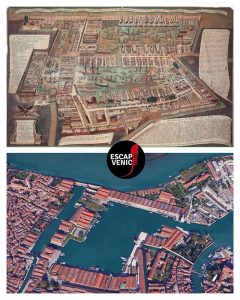
The Venice Arsenal was the beating heart of the Serenissima Republic, which based its successes on naval power and trade. The ships were built at Castello, in the Arsenale, completely surrounded by high walls so that no one could spy on the inside. The name “Arsenale”, differently from what one might think, derives from “arsene” which were the squerias where the boats were built.
Think that the surface of the Arsenal was, and is, about a tenth of that of the city of Venice because in addition to the Arsenal there were also squerias scattered in the city (one of these, the first and most important, was the Royal Gardens); from this you can understand the importance that was given to the construction of ships.
Imagine for a moment to go back to the age of the Serenissima, at the end of 1500, and to stroll along the banks of the Schiavoni. The shore was overcrowded with people because it was the embarkation for the mythical East, for the way of the silk; the channel of exit of the Arsenal was a continuous rumor of the sailors and the ships that went out ready to set sail, new of mint, many for commerce but also for facing the enemy… that then was constituted by the Turks. Think that at the time of the Battle of Lepanto even twenty galleys a day could be armed! Imagine that bustle! It is said that three thousand eight hundred men worked on it when it was up and running in eighty open worksites!!! This is also an indescribable image.
The Arsenal was completely autonomous: in addition to the ships, sails, elbows and everything that could be used to arm them were created. Think of the cheesecloth of cutters, squaders, brick makers, tinsmiths, blacksmiths, smelters, bricklayers, firemen, carpenters, caulkers and rope makers. The hustle and bustle of gunsmiths, axe masters, sail weavers and hemp spinners, warehouses, bakers for the production of the “biscuit”. Inside the arsenal there were huge ovens to feed not only the workers but also to load the pantries on the ships ready to go. A city within the city, all trades were present.
Imagine now walking into the pavilions (still open today entering from the basins or the biennial) where they assembled galleys, transport galleys… imagine the effort of men to load the cannons, the smell of wood, pitch, sweat of men.
The Venice Arsenal was the pulse of the city, without it Venice would not have become an empire. The Arsenal gave work not only in Venice but also in the whole territory on the mainland. Think of the wood that was used to build the ships! It arrived in the lagoon by water. Logs of beech, fir, oak, larch dragged by boatmen since Cadore, Cansiglio, Montello but, it is said, also from Istria and Dalmatia.
Think about the organization behind it, the minds that handled these huge amounts of material; think about the media of the time (there was no Internet, no computers, no mobile phones to order). Incredible management skills! All obviously managed with strict discipline because the Serenissima could not allow the machine to get jammed. You could not afford to steal: thieves were cut off hands, burned an eye to those who did not guard properly, hanged cheaters. Everything was recorded and written in the tombstones on the walls of the building site with date, crime and sentence… as a warning. Hard methods that are horrifying today. But the machine had to work.
The place is worth visiting and, thanks to recent restoration work, including the Arsenal Tower, is also very well preserved. The current “Great Dock” was once divided into two smaller docks (as shown in the picture) to have more space to build the galleys.
Access to the dock is not so easy and direct: you enter either from the Biennale by visiting it, or from the Bacini stop by trying to enter from the public gate where there is a bar and a small photo exhibition on the history of the Arsenal.
Impressiveness and size are still incredible today.
